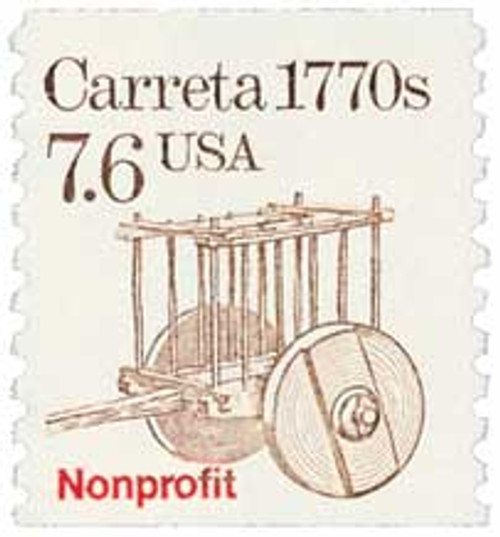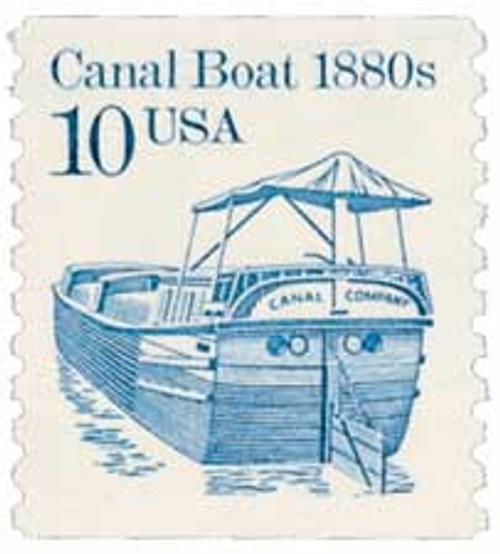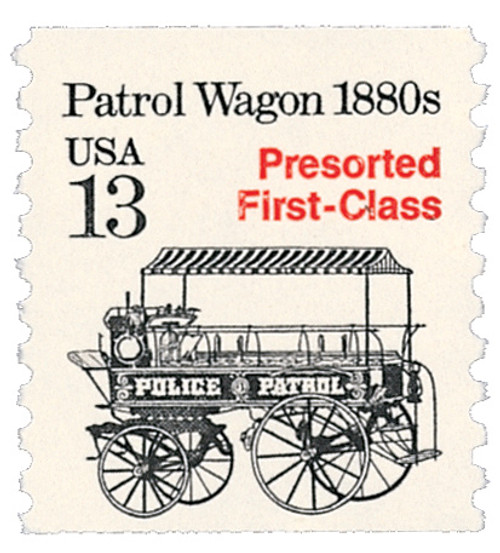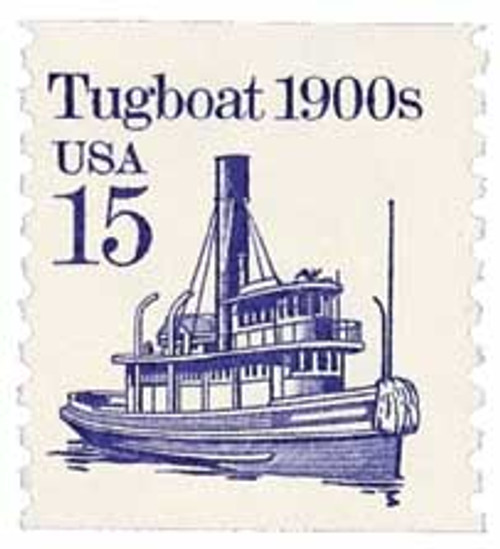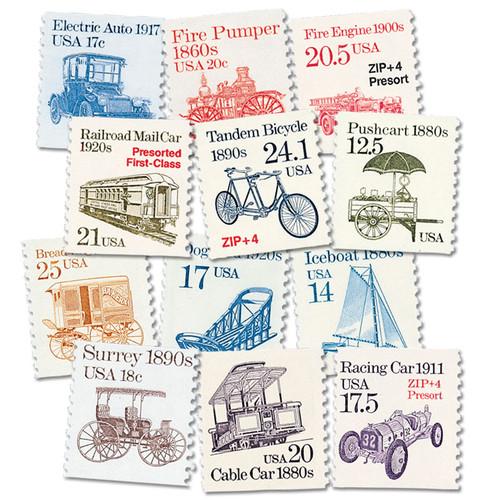
# 2255 - 1988 7.6c Transportation Series: Carreta, 1770s
U.S. #2255
1988 7.6¢ Carreta, 1770s
Transportation Series
- 38th stamp in the Transportation Series
- Oldest vehicle pictured in the series to date of its issue
Stamp Category: Definitive
Series: Transportation
Value: 7.6¢, rate for third-class non-profit bulk mail presorted to five digits
First Day of Issue: August 30, 1988
First Day City: San Jose, California
Quantity Issued: 143,272,000
Printed by: Bureau of Engraving and Printing
Printing Method: Engraved
Format: Coils of 500 and 3,000
Perforations: 10 vertical
Color: Brown
Why the stamp was issued: This stamp replaced the 1987 7.1¢ Tractor stamp which paid the rate for third-class non-profit bulk mail presorted to five digits.
The idea for a stamp picturing the carreta came from stamp collector Theron Fox. In 1977, Fox had seen the design for the unreleased First Civil Settlement in California stamp (US #1725) and noticed some errors in the design. He contacted the USPS to point them out and his changes were made to make the stamp accurate. After the Transportation Series began, he suggested the carreta to the USPS, because it was “a completely original vehicle.”
About the stamp design: Richard Schlecht created the artwork for this stamp. He based his drawing on 1977 drawings by Ralph Rambo submitted by Fox for the Civil Settlement stamp. Rambo’s drawings were considered too detailed, so Schlect was brought in to produce a simplified version for the stamp.
Special design details: This stamp has a “Nonprofit” precancel. Precancels are stamps canceled before being sold, to make mailing faster and cheaper for customers with large amounts of mail. Bulk mailers use precancels, then pre-sort their mail and save money.
First Day City: The First Day ceremony for this stamp was held at the San Jose Historical Museum in San Jose, California.
About the Transportation Series: On May 18, 1981, the USPS issued the first stamp in the Transportation Series, US #1907, picturing the Surrey, a doorless four-wheeled carriage. For the first time in US history, a coil stamp featured its own unique design rather than simply copying that of the current definitive stamp. Over 50 more coil stamps would be issued over the course of the next 15 years, each picturing a different mode of transportation. All of these types of transportation were used since American independence.
The various denominations provided face values to exactly match the rates for several categories of Third-Class mail (bulk rate and quantity-discounted mail). As the rates changed, new stamps with new values were added. Never before had a stamp series included so many fractional cent values.
The Bureau of Engraving and Printing printed most of the stamps in the Transportation Series, although private contractors printed a few. All but a few of the later stamps were produced by engraved intaglio. Differences in precancels, tagging, paper and gum provide a large number of varieties.
Scott Catalog separates the Transportation stamps into four groups. The stamps in the first group (#1897-1908) generally have the denomination in small type with a “c” next to it. These stamps were printed on the Cottrell rotary press, which joined together two plates to make a sleeve. The gaps between these plates created depressions where ink would collect and create joint lines on the stamps. Later issues were printed on a different press and didn’t have these joint lines.
The second group (#2123-36) had larger numbers with no “c.” The third group (#2252-66) was similar in appearance to the second group, but service inscriptions were added to the designs. These stamps also used a variety of paper and gum as well as different types of tagging. The fourth group (#2451-68) marked the end of fractional values. Now bulk mailers would use either the 5¢ or 10¢ stamp and then pay the difference from the actual postage rate.
The last stamp in the Transportation Series, the 20¢ Cog Railway, was issued on June 9, 1995, at the TEXPEX ’95 stamp show in Dallas, Texas. This marked the end of the largest US definitive series up to that time. Three new series would eventually replace it – American Transportation, American Culture, and American Scenes. Additionally, the Great Americans would go on to become the largest American definitive series.
History the stamp represents: The carreta, meaning "cart," in Spanish, was used by the natives and early settlers of Spanish California. This primitive vehicle, consisting of a cage mounted on large wooden wheels, was used to haul firewood and water and to transport women and children to Mass on Sundays.
When the Spanish moved into Alta California, they needed transportation. The primitive carreta was the vehicle built to fill this need. There were no wheelwrights, so wooden wheels were constructed from cross-sections of oak. Wooden pegs held the wheels to the axle. The upper portion of the cart was basically a cage lashed together with leather thongs. Tallow was used to grease the axle, but the carreta was still known for making a screeching sound as it rolled along. Carretas were usually drawn by teams of oxen.
U.S. #2255
1988 7.6¢ Carreta, 1770s
Transportation Series
- 38th stamp in the Transportation Series
- Oldest vehicle pictured in the series to date of its issue
Stamp Category: Definitive
Series: Transportation
Value: 7.6¢, rate for third-class non-profit bulk mail presorted to five digits
First Day of Issue: August 30, 1988
First Day City: San Jose, California
Quantity Issued: 143,272,000
Printed by: Bureau of Engraving and Printing
Printing Method: Engraved
Format: Coils of 500 and 3,000
Perforations: 10 vertical
Color: Brown
Why the stamp was issued: This stamp replaced the 1987 7.1¢ Tractor stamp which paid the rate for third-class non-profit bulk mail presorted to five digits.
The idea for a stamp picturing the carreta came from stamp collector Theron Fox. In 1977, Fox had seen the design for the unreleased First Civil Settlement in California stamp (US #1725) and noticed some errors in the design. He contacted the USPS to point them out and his changes were made to make the stamp accurate. After the Transportation Series began, he suggested the carreta to the USPS, because it was “a completely original vehicle.”
About the stamp design: Richard Schlecht created the artwork for this stamp. He based his drawing on 1977 drawings by Ralph Rambo submitted by Fox for the Civil Settlement stamp. Rambo’s drawings were considered too detailed, so Schlect was brought in to produce a simplified version for the stamp.
Special design details: This stamp has a “Nonprofit” precancel. Precancels are stamps canceled before being sold, to make mailing faster and cheaper for customers with large amounts of mail. Bulk mailers use precancels, then pre-sort their mail and save money.
First Day City: The First Day ceremony for this stamp was held at the San Jose Historical Museum in San Jose, California.
About the Transportation Series: On May 18, 1981, the USPS issued the first stamp in the Transportation Series, US #1907, picturing the Surrey, a doorless four-wheeled carriage. For the first time in US history, a coil stamp featured its own unique design rather than simply copying that of the current definitive stamp. Over 50 more coil stamps would be issued over the course of the next 15 years, each picturing a different mode of transportation. All of these types of transportation were used since American independence.
The various denominations provided face values to exactly match the rates for several categories of Third-Class mail (bulk rate and quantity-discounted mail). As the rates changed, new stamps with new values were added. Never before had a stamp series included so many fractional cent values.
The Bureau of Engraving and Printing printed most of the stamps in the Transportation Series, although private contractors printed a few. All but a few of the later stamps were produced by engraved intaglio. Differences in precancels, tagging, paper and gum provide a large number of varieties.
Scott Catalog separates the Transportation stamps into four groups. The stamps in the first group (#1897-1908) generally have the denomination in small type with a “c” next to it. These stamps were printed on the Cottrell rotary press, which joined together two plates to make a sleeve. The gaps between these plates created depressions where ink would collect and create joint lines on the stamps. Later issues were printed on a different press and didn’t have these joint lines.
The second group (#2123-36) had larger numbers with no “c.” The third group (#2252-66) was similar in appearance to the second group, but service inscriptions were added to the designs. These stamps also used a variety of paper and gum as well as different types of tagging. The fourth group (#2451-68) marked the end of fractional values. Now bulk mailers would use either the 5¢ or 10¢ stamp and then pay the difference from the actual postage rate.
The last stamp in the Transportation Series, the 20¢ Cog Railway, was issued on June 9, 1995, at the TEXPEX ’95 stamp show in Dallas, Texas. This marked the end of the largest US definitive series up to that time. Three new series would eventually replace it – American Transportation, American Culture, and American Scenes. Additionally, the Great Americans would go on to become the largest American definitive series.
History the stamp represents: The carreta, meaning "cart," in Spanish, was used by the natives and early settlers of Spanish California. This primitive vehicle, consisting of a cage mounted on large wooden wheels, was used to haul firewood and water and to transport women and children to Mass on Sundays.
When the Spanish moved into Alta California, they needed transportation. The primitive carreta was the vehicle built to fill this need. There were no wheelwrights, so wooden wheels were constructed from cross-sections of oak. Wooden pegs held the wheels to the axle. The upper portion of the cart was basically a cage lashed together with leather thongs. Tallow was used to grease the axle, but the carreta was still known for making a screeching sound as it rolled along. Carretas were usually drawn by teams of oxen.

